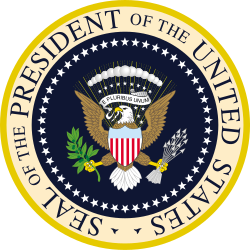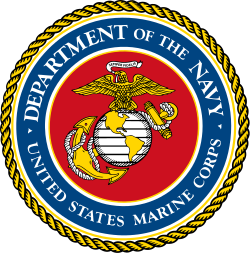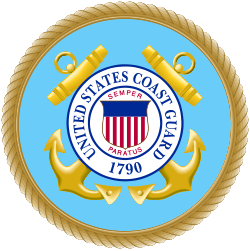Andrews Air Force Base

Andrews Air Force Base[1] (numera Joint Base Andrews) (IATA: ADW, ICAO: KADW) är en amerikansk flygvapenbas belägen 13 km öster om Washington, DC i Prince George's County, Maryland, USA. Andrews är mest känd som platsen där de tvenne flygplanen av typ Boeing 747 VC-25A, bland gemene man mer kända som Air Force One, har sin basering samt att det också i regel är utgångspunkten för presidentens flygresor. Andrews är också vanligtvis den flygplats som gästande stats- och regeringschefer anländer till vid besök i Washington, DC.
Bakgrund
Ursprungligen från uppförandet 1942 hette flygfältet Camp Springs Army Air Base. 1945 fick basen sitt nuvarande namn, till minnet av generallöjtnant Frank M. Andrews (1884-1943) som var en av nyckelpersonerna i uppbyggnaden av US Army Air Force.
Se även
- Joint Base Anacostia-Bolling
- Naval Air Station Patuxent River
Källor
- Den här artikeln är helt eller delvis baserad på material från engelskspråkiga Wikipedia, Joint Base Andrews, 27 januari 2013.
Notförteckning
- ^ Numera Joint Base Andrews Naval Air Facility Washington
Externa länkar
- (engelska) Andrews Air Force Base - officiell webbplats.
| ||||||||
Media som används på denna webbplats
An aerial view of the Air Force One hangar facility at the base. One of two VC-25A presidential transport aircraft operated by the 89th Airlift Wing is parked outside the hangar.
U.S. Department of The Army Emblem.
- In the center is a Roman cuirass below a vertical unsheathed sword, point up, the pommel resting on the neck opening of the cuirass and a Phrygian cap supported on the sword point, all between on the right an esponton and on the left a musket with fixed bayonet crossed in saltire behind the cuirass and passing under the sword guard.
- To the right of the cuirass and esponton is a flag of unidentified designs with cords and tassels, on a flagstaff with spearhead, above a cannon barrel, the muzzle end slanting upward behind the cuirass, in front of the drum, with two drumsticks and the fly end of the flag draped over the drumhead; below, but partly in front of the cannon barrel, is a pile of three cannon balls.
- To the left of the cuirass and musket is a national color of the Revolutionary War period, with cords and tassels, on a flagstaff with spearhead, similarly arranged above a mortar on a carriage, the mortar facing inward and in front of the lower portion of the color and obscuring the lower part of it; below the mortar are two bomb shells placed side by side.
- Centered above the Phrygian cap is a rattlesnake holding in its mouth a scroll inscribed "This We'll Defend."
- Centered below the cuirass are the Roman numerals "MDCCLXXVIII."
- For differences between this text description and the emblem shown above, see "Army Seal vs. Army Emblem", below.
Seal of USA:s flygvapendepartement - militärdepartement inom USA:s försvarsdepartement
Seal of the United States Marine Corps. It is defined in Executive Order 10538 (alternate source) as:
For more information, see here.Standing upon the western hemisphere of the terrestrial globe containing the lines of latitude and topographical outlines of North, Central, and South America, an American bald eagle with wings displayed horizontally and inverted holding in his beak a scroll inscribed with the motto SEMPER FIDELIS, all bronze. Behind the western hemisphere a foul anchor bend sinister-wise with stock, arms, and flukes in slight perspective, all bronze, on a scarlet background and within a dark blue band edged in gold circumscribed by a gold rope rim and inscribed DEPARTMENT OF THE NAVY • UNITED STATES MARINE CORPS in gold letters. The central device of the seal is the emblem of the United States Marine Corps.
United States Coast Guard Seal, in correct PMS colors. This emblem shall only be used in accordance with the Coast Guard Heraldry Manual, and is not to be reproduced commercially without prior approval of the U.S. Coast Guard.
*Description: On a circular background of fair sky and moderate sea with land in sinister base, a tri-mast square rigged ship under way before a fair breeze with after top-sail furled, commission pennant atop the foremast, National Ensign atop the main, and the commodore's flag atop the mizzen. In front of the ship a luce-type anchor inclined slightly bendwise with the crown resting on the land and, in front of the shank and in back of the dexter fluke, an American bald eagle rising to sinister regarding to dexter, one foot on the ground, the other resting on the anchor near the shank; all in proper colors. The whole within a blue annulet bearing the inscription "Department of the Navy" at the top and "United States of America" at the bottom, separated on each side by a mullet and within a rim in the form of a rope; inscription, rope, mullet, and edges of annulet all gold. *Background: The policy for use of the Navy seal and emblem is contained in SECNAV Instr 5030.4 and SECNAV Instr 5030.6. The seal design was approved by the President of the United States by Executive Order 10736 dated October 23, 1957. Request for use of the Navy emblem should be submitted in writing to Defense Printing Service, ATTN: DPSMO, 8725 John Kingman Rd Suite 3239, Fort Belvoir, VA 22060-6220. The telephone number is (703) 767-4218. 1879 version here: http://etc.usf.edu/clipart/54900/54985/54985_seal_navy.htm








